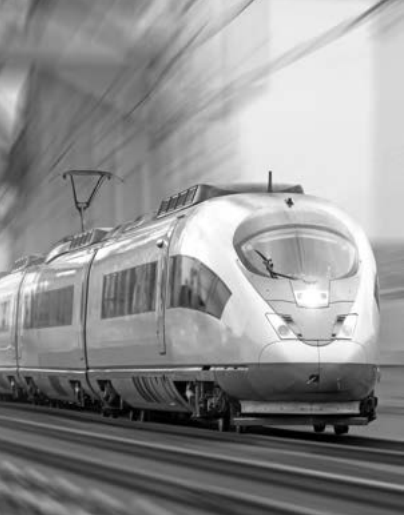In the domain of rail, the durability and endurance of rolling stock are paramount both from engineering and business perspectives. Modern locomotives and train systems, constructed with advanced materials and engineering practices, are designed for 30-35 years of service life. This longevity is crucial for maintaining efficient, sustainable transport networks that prioritize passenger safety and comfort. However, the rapid pace of technological evolution presents a formidable challenge: obsolescence, particularly of electrical and electronic subsystems. This white paper delves into the essence of obsolescence management within the rail industry, outlining effective strategies for extending the operational lifespan of rail assets while ensuring safety and reliability.
Addressing obsolescence in rail transport is a complex task. Electronic and electrical components within trains, pivotal for operations, often have shorter life cycles compared to the trains they serve. The discrepancy between the robust physical structures of trains and the aging technological components they house creates a mismatch.
The rail industry is actively seeking solutions to mitigate these challenges. Innovative techniques, such as 3D printing, are becoming increasingly significant, Offering -on-demand production capabilities for parts at risk of obsolescence. This advancement points to a future where maintenance and manufacturing can adapt swiftly to the needs of aging rolling stock, ensuring continuity and safety.
The rail industry grapples with a unique challenge when it comes to obsolescence. The robust build of locomotives and carriages, engineered for endurance, often outlasts the more transient nature of their electronic components. These vital pieces, integral to the smooth functioning of operations, are built with a relatively shorter operational life—typically between five to fifteen years. As technology races forward, leaving older systems in its wake, these electronic components reach their end-of-life at an alarming rate, leaving operators scrambling to find replacements. The discontinuation of these critical parts has widespread implications, threatening the very backbone of the rail system’s safety and reliability.
Compounding the issue is a set of multi-layered hurdles. First is the sheer scarcity of suitable replacement parts, as the original components become relics of a bygone technological era. Then there's the compatibility conundrum—modern replacements often do not mesh well with the existing legacy systems, creating a jigsaw puzzle that can be complex and costly. Finally, the regulatory labyrinth presents its own set of challenges, where integrating contemporary technology into age-old systems must navigate the stringent requirements of safety and compliance standards. This trifecta of obstacles necessitates a sophisticated and strategic approach to managing obsolescence, ensuring the longevity of rail vehicles without compromising performance or safety.
In the dynamic landscape of rail operations, managing obsolescence is a critical endeavor. As trains and their electric components age, the risk of obsolescence looms large, impacting safety, reliability, and efficiency. To address this challenge, rail operators employ strategic approaches that span early identification, standardization, supplier collaboration, and technology integration
To minimize risk and manage costs effectively in the rail industry, it’s essential to have a thorough obsolescence management framework. This framework requires rigorous analysis and comprehensive documentation to assess the lifecycle of every component. Through meticulous documentation of each vital components status and tracking its lifespan, rail system manufactures can proactively prepare for the phases of a component's lifecycle – from active use through to discontinuation. This predictive approach enables the anticipation of potential risks and allows for the strategic planning of inventory, ensuring the availability of critical components before they become obsolete.
Within this framework, assessing the risks associated with the obsolescence of each component is a critical step. Manufacturers can prioritize their mitigation efforts effectively by understanding the specific impact a component's failure could have on the system's safety, performance, and compliance. This prioritization is crucial for developing tailored strategies, which may range from securing a last-time buy of critical parts to exploring alternative suppliers or redesigning systems with newer, more readily available technologies. These mitigation strategies ensure that the rail operators are not caught off guard and that safe service continuity is upheld.
Finally, the obsolescence management framework is not static; it must evolve with the technological landscape and market conditions. This requires regular reviews and updates, integrating new data and insights into the Obsolescence management plan. Such iterative updates allow for the incorporation of new technologies and methods, such as additive manufacturing, which can provide innovative ways to address part obsolescence. Adapting to these changes ensures that the rail systems maintain their current performance levels and are positioned to leverage advancements that can extend their operational life and enhance efficiency.

At Quest Global, we understand the intricate dynamics of the rail industry and the critical importance of obsolescence management. With decades of experience and a team of dedicated engineering experts, Quest Global is uniquely positioned to support rail operators and manufacturers in navigating the complexities of obsolescence management. Our comprehensive services, from risk assessment and planning to design and engineering, supply chain management, and implementation support, empower our clients to stay ahead of obsolescence challenges. Our strategy includes a comprehensive risk assessment, where we evaluate the obsolescence impact of each component, considering how critical each is to the product's function, performance, and cost. Components that are rapidly approaching obsolescence receive priority in our planning Our teams monitor component lifecycles and market trends, allowing us to deliver bespoke plans that outline strategic mitigation efforts, including cost-effective solutions and precise implementation schedules.
Quest Global’s engineering teams offers design services and support to our customers. We integrate contemporary technologies in a very seamless way. In supply chain management, we're proactive, identifying alternative suppliers, securing long-term contracts, and effectively managing component reserves. When it comes to implementation and ongoing support, Quest Global stands out with its comprehensive project management, technical support, and the implementation of state-of-the-art obsolescence management strategies. With Quest Global as a strategic partner, rail industry leaders, manufacturing companies and rail operators can be rest assured that their rolling stock is not only equipped to meet today's demands but is also prepared to evolve with the technological advancements of tomorrow, ensuring safety, reliability, and sustainability for the long haul.

Principal Engineer - Rail, Quest Global